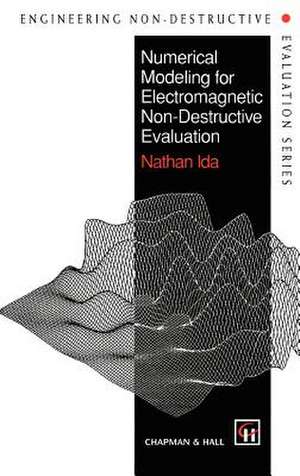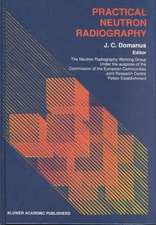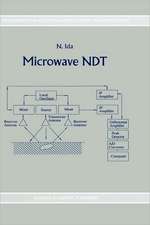Numerical Modeling for Electromagnetic Non-Destructive Evaluation
Autor N. Idaen Limba Engleză Hardback – 31 dec 1994
| Toate formatele și edițiile | Preț | Express |
|---|---|---|
| Paperback (1) | 1227.84 lei 6-8 săpt. | |
| Springer Us – 22 oct 2013 | 1227.84 lei 6-8 săpt. | |
| Hardback (1) | 1233.20 lei 6-8 săpt. | |
| Springer Us – 31 dec 1994 | 1233.20 lei 6-8 săpt. |
Preț: 1233.20 lei
Preț vechi: 1503.90 lei
-18% Nou
Puncte Express: 1850
Preț estimativ în valută:
236.01€ • 245.75$ • 199.46£
236.01€ • 245.75$ • 199.46£
Carte tipărită la comandă
Livrare economică 10-24 martie
Preluare comenzi: 021 569.72.76
Specificații
ISBN-13: 9780412468308
ISBN-10: 0412468301
Pagini: 532
Ilustrații: XVI, 511 p.
Dimensiuni: 156 x 234 x 34 mm
Greutate: 0.89 kg
Ediția:1994
Editura: Springer Us
Colecția Springer
Locul publicării:New York, NY, United States
ISBN-10: 0412468301
Pagini: 532
Ilustrații: XVI, 511 p.
Dimensiuni: 156 x 234 x 34 mm
Greutate: 0.89 kg
Ediția:1994
Editura: Springer Us
Colecția Springer
Locul publicării:New York, NY, United States
Public țintă
ResearchCuprins
1 Elliptic, parabolic and hyperbolic processes.- 2 General approaches to solution of field problems.- 3 The analytic approach.- 4 The numerical approach in NDT.- 5 Numerical methods.- 1. The electromagnetic field equations.- 1.1 Introduction.- 1.2 Maxwell’s equations in differential form.- 1.3 Maxwell’s equations in integral form.- 1.4 Constitutive relations.- 1.5 Electromagnetic interface conditions.- 1.6 Material properties.- 1.7 Hysteresis.- 1.8 Magnetization.- 1.9 Permanent magnets.- 1.10 The Poynting theorem.- 1.11 Potential functions.- 1.12 Gage condition.- 1.13 Field equations in terms of potential functions.- 1.14 Derivation in terms of scalar potentials.- 1.15 Time-harmonic fields.- 1.16 Nonlinear fields.- 1.17 Plane waves and scattering.- 1.18 Propagation of waves: plane waves.- 1.19 Propagation of plane waves in lossy media.- 1.20 Microwaves, waveguides and resonant cavities.- 1.21 Skin depth.- 1.22 Classification of field equations.- 1.23 Problems.- 1.24 Bibliography.- 2. Analytic methods of solution.- 2.1 Introduction.- 2.2 Analytic methods.- 2.3 Separation of variables: solution to Laplace’s equation.- 2.4 Example: skin effect.- 2.5 Example: TM modes in a rectangular waveguide.- 2.6 Green’s function method.- 2.7 Conformal mapping.- 2.8 Other methods.- 2.9 Problems.- 2.10 Bibliography.- 3. The finite difference method.- 3.1 Introduction.- 3.2 The finite difference approximation.- 3.3 The finite difference grid.- 3.4 Explicit and implicit finite difference methods.- 3.5 Finite difference approximation for time dependent equations.- 3.6 Inclusion of material properties.- 3.7 Problems.- 3.8 Bibliography.- 4. The finite element method.- 4.1 Introduction.- 4.2 The finite element approximation.- 4.3 The finite element method.- 4.4 The finite element.- 4.5Finite element formulation.- 4.6 The finite element mesh.- 4.7 Two-dimensional mesh generation.- 4.8 Pre-processing software.- 4.9 Problems.- 4.10 Bibliography.- 5. Elliptic partial differential equations.- 5.1 Introduction.- 5.2 The general elliptic partial differential equation.- 5.3 Classes of problems.- 5.4 Applications to NDT.- 5.5 2-D, axisymmetric, and 3-D applications: differences and similarities.- 5.6 Bibliography.- 6. Finite difference solution of elliptic processes.- 6.1 Introduction.- 6.2 Elliptic processes: applications in 2-D and 3-D electrostatics.- 6.3 Magnetostatic applications.- 6.4 Eddy Current applications.- 6.5 Time-harmonic wave propagation.- 6.6 Nonlinear applications.- 6.7 Problems.- 6.8 Bibliography.- 7. Finite element formulation.- 7.1 Introduction.- 7.2 Choice of formulations and finite elements (2-D and 3-D).- 7.3 Formulation using an energy functional: variational approach.- 7.4 Formulation using Galerkin’s method.- 7.5 Examples: static applications.- 7.6 Examples: eddy current applications.- 7.7 Examples: axisymmetric applications.- 7.8 Examples: three-dimensional applications.- 7.9 Extensions and modifications.- 7.10 Problems.- 7.11 Bibliography.- 8. Boundary integral, volume integral and combined formulations.- 8.1 Introduction.- 8.2 Boundary integral methods.- 8.3 The method of moments: an intuitive approach.- 8.4 Integral equations.- 8.5 Finite element implementation.- 8.6 Integral equations for static fields.- 8.7 Problems.- 8.8 Bibliography.- 9. Parabolic partial differential equations.- 9.1 Introduction.- 9.2 The general parabolic partial differential equation.- 9.3 Transient finite element formulation.- 9.4 Transient finite difference formulation.- 9.5 Three-dimensional solutions.- 9.6 Finite difference time domain methods.- 9.7Examples.- 9.8 Problems.- 9.9 Bibliography.- 10. Hyperbolic partial differential equations.- 10.1 Introduction.- 10.2 The general hyperbolic partial differential equation.- 10.3 The finite difference time domain method.- 10.4 Examples.- 10.5 Problems.- 10.5 Bibliography.- 11. Miscellaneous numerical methods.- 11.1 Introduction.- 11.2 Numerical integration.- 11.3 Numerical differentiation.- 11.4 Solution of linear systems of equations.- 11.5 Solution of nonlinear systems of equations.- 11.6 Methods of solution for eigenvalues and eigenvectors.- 11.7 Insertion of Dirichlet boundary conditions.- 11.8 Bibliography.















